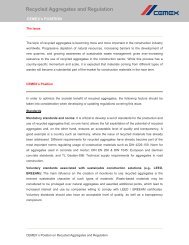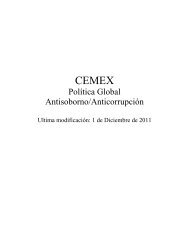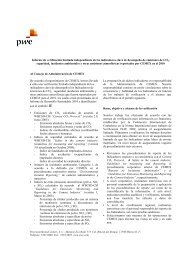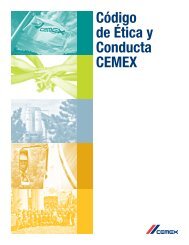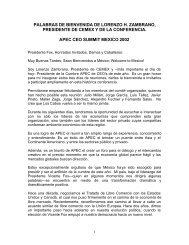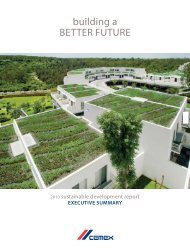building a STRONGER foundation - Cemex
building a STRONGER foundation - Cemex
building a STRONGER foundation - Cemex
Create successful ePaper yourself
Turn your PDF publications into a flip-book with our unique Google optimized e-Paper software.
Significant judgment is required to appropriately assess the value in use of our reporting units. Impairment evaluations are<br />
significantly sensitive to, among other factors, the estimation of future prices of our products, the development of operating expenses,<br />
local and international economic trends in the construction industry, as well as the long-term growth expectations in the different<br />
markets. Likewise, the discount rates and the rates of growth in perpetuity used have an effect on such impairment evaluations. We<br />
use specific after-tax discount rates for each reporting unit, which are applied to after-tax cash flows. Our specific discount rates<br />
consider the weighted average cost of capital of each geographic segment. This determination requires substantial judgment and is<br />
highly complex when considering the many countries in which we operate, each of which has its own economic circumstances that<br />
have to be monitored. Undiscounted cash flows are significantly sensitive to the growth rates in perpetuity used. Likewise, discounted<br />
cash flows are significantly sensitive to the discount rate used. The higher the growth rate in perpetuity applied, the higher the amount<br />
obtained of undiscounted future cash flows by reporting unit. Conversely, the higher the discount rate applied, the lower the amount<br />
obtained of discounted estimated future cash flows by reporting unit. Additionally, we monitor the lives assigned to these long-lived<br />
assets for purposes of depreciation and amortization, when applicable. This determination is subjective and is integral to the<br />
determination of whether impairment has occurred.<br />
During the fourth quarter of 2008, the global economic environment was negatively affected by the intensification of the turmoil<br />
in several major financial institutions, which caused a liquidity shortage for companies in almost all productive sectors which, in turn,<br />
resulted in a significant decrease in overall economic activity and a downturn in global equity markets. These situations generated a<br />
reduction of growth expectations in the countries in which we operate, motivated by the cancellation or deferral of several investment<br />
projects, particularly affecting the construction industry. Although in 2009 and 2010 most global macroeconomic variables have<br />
stabilized, the construction industry has remained depressed in certain countries mainly as a result of the high level of inventories<br />
existing at the beginning of the financial crisis, and the lack of investment projects considering the reaction of investors to the liquidity<br />
problems in countries like Greece, Spain, Ireland and Portugal, among others.<br />
During the last quarter of 2010, 2009 and 2008, we performed our annual goodwill impairment test. Based on these analyses, in<br />
2010, we determined an impairment loss of goodwill for approximately Ps189 million (U.S.$15 million) associated with the reporting<br />
unit in Puerto Rico, whereas, in 2008, we determined impairment losses of goodwill for a total of approximately Ps18.3 billion<br />
(U.S.$1.3 billion), associated with CEMEX’s reporting units in the United States, Ireland and Thailand for approximately Ps16.8<br />
billion (U.S.$1.2 billion), Ps233 million (U.S.$17 million) and Ps453 million (U.S.$33 million), respectively. The estimated<br />
impairment loss in the United States in 2008 was mainly attributable to our acquisition of Rinker in 2007, and overall such losses were<br />
attributable to the economic environment described in the paragraph above. In addition, considering that our investment in Venezuela<br />
is expected to be recovered through different means other than use, we recognized in 2008 an impairment loss of approximately Ps838<br />
million (U.S.$61 million) associated with cancellation of the goodwill of this investment. For the year 2009, based on our goodwill<br />
impairment tests, we did not determine any impairment losses of goodwill. See notes 11 and 11B to our consolidated financial<br />
statements included elsewhere in this annual report.<br />
The discount rate and the cash flows from each country include their respective income tax rates. Discount rates and growth<br />
rates in perpetuity used in the reporting units that represent most of the consolidated balance of goodwill under MFRS in 2010 and<br />
2009 are as follows:<br />
Discount rates Growth rates<br />
Reporting units 2010 2009 2010 2009<br />
United States ......................................................................................... 8.7% 8.5% 2.5% 2.9%<br />
Spain...................................................................................................... 10.2% 9.4% 2.5% 2.5%<br />
Mexico................................................................................................... 10.0% 10.0% 2.5% 2.5%<br />
Colombia............................................................................................... 10.0% 10.2% 2.5% 2.5%<br />
France.................................................................................................... 9.6% 9.6% 2.5% 2.5%<br />
United Arab Emirates............................................................................ 11.5% 11.4% 2.5% 2.5%<br />
United Kingdom.................................................................................... 9.7% 9.4% 2.5% 2.5%<br />
Egypt ..................................................................................................... 11.1% 10.0% 2.5% 2.5%<br />
Range of discount rates in other countries............................................. 10.3% – 13.9% 9.6% – 14.6% 2.5% 2.5%<br />
In addition, during 2010, 2009 and 2008, we recognized impairment losses of property, plant and equipment in connection with<br />
the permanent closing of operating assets for an aggregate amount of approximately Ps1,161 million (U.S.$92 million), Ps503 million<br />
(U.S.$38 million) and Ps1.0 billion (U.S.$76 million), respectively. See note 10 to our consolidated financial statements included<br />
elsewhere in this annual report.<br />
82



